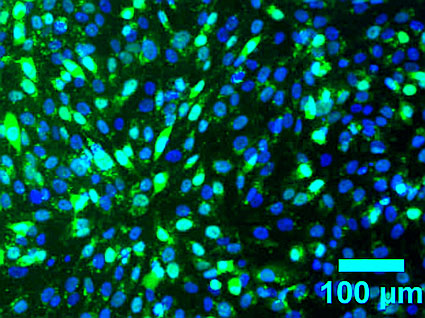Researchers at Brown University have developed a set of tailor-made ‘molecular beacons’ that enables researchers to perform real-time observation of gene expression in live stem cell populations during their transformation into a particular tissue.

Glowing green spots in these MG-63 bone cells (each blue dot is a nucleus) indicate that a fluorescent 'beacon' molecule has bound to RNA produced by expression of the bone-specific ALPL gene. (credit: Darling Lab/Brown University)
This technology provides a potentially powerful tool that helps researchers find the ways required for the swift transformation of stem cells into desired tissue cells, a key objective in the development of regenerative medicine treatments. The study results have appeared in the Tissue Engineering Part A journal.
Researchers, Hetal Desai and Eric Darling, engineered the beacons to fluoresce during their binding to mRNA from three particular genes in fat-derived stem cells that generate expressions only during the transformation of stem cells into bone cells. Desai informed that during 21 days of their growth, the cells stayed alive and free, and some populations obtained a chemical stimulation toward transforming into bone, while others did not.
Over this period, the researchers observed the populations for the beacons’ fluorescence to detect the number of stem cells in each population that were transformed into bone and the duration of each gene expression milestone. The beacons' fluorescence facilitated the researchers to observe a unique pattern in that duration. Each consecutive episode of gene expression rapidly increased from zero to the peak, thus providing a new theory that the rate of ‘differentiation’ in stem cell parlance or stem cell transformation may occur in a more synchronized way over time in a population.
In the mean time, the stem cell populations that were not stimulated with bone-promoting chemicals demonstrated virtually no gene expression or beacon fluorescence, confirming that the beacons were served as truly indictors of steps during the stem cell transformation into bone. The beacons were designed to perform their role without affecting the development or functioning of cells.
According to Darling, in tissue engineering, the technology can be helpful in determining the favorable conditions for the rapid transformation of stem cells into desired tissues, finding the best timing for the addition of an inducing chemical, and providing a way of detecting and harvesting only those cells that are transforming into the desired tissue. In a broader sense, molecular beacons can be utilized in different gene expression studies.
Disclaimer: The views expressed here are those of the author expressed in their private capacity and do not necessarily represent the views of AZoM.com Limited T/A AZoNetwork the owner and operator of this website. This disclaimer forms part of the Terms and conditions of use of this website.